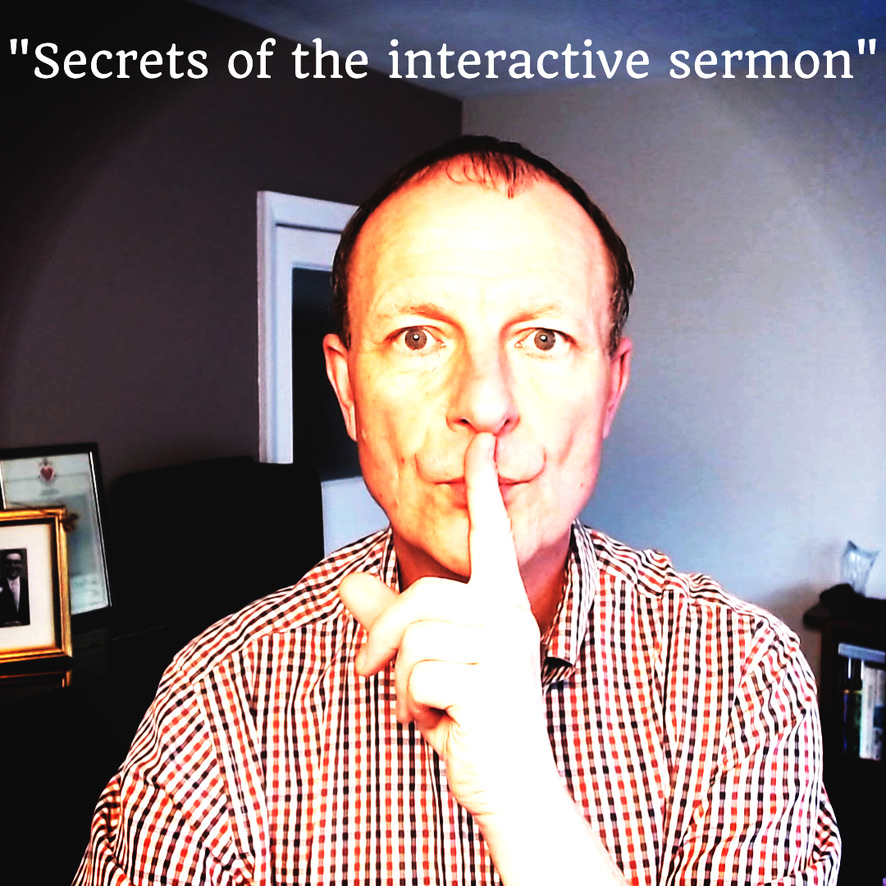Tuesday Teaching Tips, Episode 193
Today’s episode comes courtesy of inspiration provided by a conversation I had last week.
Albert and Angela May came over to discuss vision and plans for the ministry in Beaconsfield. We had a thoroughly edifying time discussing ideas and sharing experiences. I found much to enrich the way I’m thinking about our ministry here in Watford.
One of the topics we discussed was our services. I described how in Watford we often vary the format of our services and the methods we use to deliver a message. We ended up talking about interactive sermons. You know the kind of thing. Question-and-answer from the speaker to the congregation forth and back. Breaking into small groups or even large groups for discussion as part of the sermon. And suchlike.
Angela made a very good point as we discussed this. Which was that it takes quite a bit of confidence on the part of the speaker to engage in this kind of free-form speaking. I agreed with her. But I also think it’s something that every speaker can develop if they wish to.
One of the reasons I feel strongly that this should be part of any speakers armoury is that it was part of Jesus’. There were times when he taught lessons, you could say. For example, the sermon on the Mount – Matthew 5-7. However, there were also many times when he was interrupted, or asked a question of his audience and interacting with their replies.
If we’re going to preach and teach like Jesus, we’re going to need to be able to handle questions and use questions effectively. Let’s spend some time together thinking this through. I will share with you the benefit of what I have learned so far, and I look forward to having your feedback to improve what I’m doing.
First of all, four reasons for engaging in these kinds of sermons:
- Jesus did it. You can hardly open a page of the Gospels without seeing Jesus pose a question, respond to a question, provoke discussion, participate in a discussion and, generally, interact with those around him. Sometimes it’s the crowd, on other occasions his disciples. He engages in this way with the Pharisees, Pilate, strangers and friends. Take Matthew 11 for example. The disciples of John the Baptist ask him a question to which he responds by asking them to examine the evidence of his ministry. As those disciples depart Jesus takes the opportunity to speak to the crowd about John the Baptist and explain that he was more than a prophet. He uses a rhetorical question in verse 16 to explain the characteristics of the generation he was addressing. A significant proportion of Jesus’ public teaching was interactive engagement with his hearers.
- You learn about your congregation and visitors. A side-blessing of interactive sermons is their pastoral usefulness. When you hear people interacting with Scripture and yourself, you’re learning something about their thinking about God, the Bible and themselves. Recently I asked a question and a person responded with an answer that had nothing to do with the question. I felt annoyed. But I realised, partway through my annoyance, that this person was telling me something about themselves. I needed to pay attention. The Spirit was moving and revealing things. So, even if you feel a particular interactive sermon hasn’t gone as well as you’d hoped, or hadn’t remained on topic in the way that you had planned, do not despair. It could be that was exactly what was meant to happen.
- You help some people learn who learn best in this kind of learning environment. One of the members of the Watford church, Tunde, told me that he learns best in these kinds of sermons. He remembers more, takes more in and finds it easier to apply the sermon when there has been some discussion between himself and other people. You likely have people like that in your congregation. Serve them well by incorporating interactive sermons as part of your preaching package.
- You model good Bible study. It’s a responsibility of a preacher to preach in such a way as to model healthy approaches to studying the Bible. When we interact with the congregation, asking questions, or asking them to break into groups to discuss a topic, we are helping them to develop a healthy approach to their own Bible study. Part of the reason I do these kinds of sermons is the hope that the congregation members and visitors will go home, open their Bible and practice the same kind of technique in their personal Bible study.
Now, seven practical points:
- Start somewhere. You may not feel particularly qualified or skilled in this area. Join the club. I began incorporating interactivity into my sermons about 15 years ago in Cricklewood. I didn’t have a model – although I had in mind some of my favourite comedians who I’d seen interact with their audiences. I do think, by the way, that all preachers and teachers should study the comedic arts. It’s not that we are trying to be comedians, but comedians learn how to read an audience, how to interact with them and how to do so with timing which helps get their point across. In any case, we have to start somewhere. I didn’t have training nor mentoring in this area. I simply started and learned from there. I encourage you, especially if you feel insecure about this, to bear in mind that the congregation is, at least most of the time, on your side! They will forgive you if you stretch yourself in this area. They will know it is hard, but they will appreciate your attempts to bring a freshness to the preaching which will help them as they learn from God’s word.
- Make the questions visible. I put the questions on screen and on a handout. It is challenging for a congregation to remember a question you have asked if they do not have it in front of them. This is especially true if you’re expecting people to work in small groups. We have people in congregations who are hard of hearing, dyslexic, do not speak English as their first language and have other challenges with words and language. Help them out by making the questions visible.
- Make the timing clear. If I’m breaking the congregation into groups for discussion, I give a clear time-limit. This will usually be between two and five minutes. The average is probably three minutes. Too short it and there is not enough time for meaningful discussion. Too long and the discussion will get off-track. I ensure that I do not get off track by setting a timer on my phone or putting a countdown timer on screen.
- Respond positively. You will occasionally get answers which are off-topic or plain bonkers! You don’t have to say, “That’s a great point.” to such answers. That would be insincere. Instead simply smile, say “Thank you”, and move on to the next person.
- Do not interrupt people unless they are being disruptive or giving a very long-winded answer. I have seen people try the interactive approach, but interrupt the congregants when they’ve only got halfway through what they’re saying. It’s not only rude, and discourages other people from commenting, but you also don’t get the benefit of their full answer.
- Ask open-ended questions. The best questions are usually ones that engage people’s imagination. For example, this last Sunday when preaching on Mark 4 and the calling of the first disciples, I asked the question, “What do you think the disciples understood Jesus to be calling them to when he called them to follow him?” That a longer question than I prefer to use, but I’m trying to help the congregation to engage their imagination. Not so much, “What did Jesus call them to”, but “What did they think they were being called to”. Avoid questions which have only one answer. Instead, ask questions which will reveal things.
- Work very hard on getting your questions right. The most important part of this whole enterprise is to craft engaging, stimulating and meaningful questions. The point of the question might seem obvious to you. But it may not to the congregation. Try to imagine yourself receiving the question and ask yourself if you would be clear about what you are being asked. It’s happened on more than one occasion that I have asked a question and observed the congregation looking back at me with frowns on their faces. Two weeks ago I asked a question in a sermon. Barry Edwards put up his hand and asked what I meant. I was so embarrassed! But he was right. In that moment I realised that there was an ambivalence about the question. I rephrased it with a clearer point, Barry was satisfied and so were the congregation. “Thank you, Barry.” You won’t get all your questions right. That’s just the way it is. But, work hard on your questions.
Questions are not the only way of creating an interactive sermon. But I focused on questions today because, especially if you are not familiar with this approach, it is the easiest way to get into delivering interactive sermons. You can do all kinds of things with props, games, impromptu skits, flip charts, post-it notes and much more. Perhaps we will go on to those another day. But if you master the use of questions, you will have mastered the most significant of all interactive sermon tools.
What I’d like to know today is:
“What do you think is the best way to conduct interactive sermons which contribute healthily to the spiritual education of a congregation?”
Please add your comments on this week’s topic. We learn best when we learn in community.
Do you have a question about teaching the Bible? Is it theological, technical, practical? Send me your questions or suggestions. Here’s the email: malcolm@malcolmcox.org.
If you’d like a copy of my free eBook on spiritual disciplines, “How God grows His people”, sign up at my website: http://www.malcolmcox.org.
Please pass the link on, subscribe, leave a review.
“Worship the LORD with gladness; come before him with joyful songs.” (Psalms 100:2 NIV11)
God bless, Malcolm
PS: You might also be interested in my book: “An elephant’s swimming pool”, a devotional look at the Gospel of John



